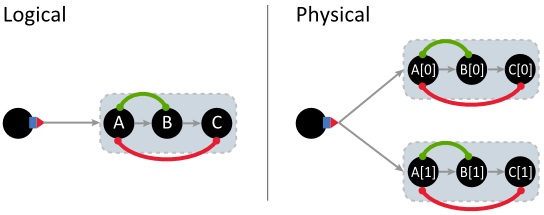Host constraints in parallel regions
By default, host placement options that you specify for operators in a parallel region apply to
all channels in the region. To specify host constraints relative to the channels in a parallel
region, use the getChannel() built-in function in the host placement expressions.
The host placement configurations that accept the getChannel() built-in function
are host, hostColocation, and hostExlocation.
(The host placement configuration hostIsolation does not accept any parameters.)
The parallel transformation copies the host placement configuration options from the logical
operators to the replicated physical operators. These configuration options constrain whether
channels must (hostColocation) or must not (hostExlocation) run on
the same host, or whether they run in a partition that has a host of their own
(hostIsolation).
The parallel transformation resolves the getChannel() function at submission time
with the correct channel number for the replicated operator.
To place sibling operators from a parallel region on different sets of hosts, specify the
replicateHostTags element in the parallel annotation. The
replicateHostTags element uses host tags to determine whether to replicate any of
the host pools that are used inside of a parallel region. When a host pool is replicated, it means
that a new host pool is created for each channel, and its host tag is updated to indicate the
channel that it is in. Each replicated host pool is used by only one channel in a parallel region
but it can be used by multiple operators in the same channel. A host pool can also be used by
multiple parallel regions, in which case each channel in each parallel region obtains a separate
replica of the host pool.
The host placement configuration options hostColocation and
hostExlocation can be used with the replicateHostTags element. For
example, you can use the replicateHostTags element to ensure that all operators in
a channel are on the same set of hosts, but are on a different set of hosts than operators in other
channels. The hostColocation and hostExlocation options can then
determine where operators are placed within that set of hosts.
In nested parallel regions, the host pool replication in a given
parallel region is independent of replication in any other parallel region. The host pools
replicated using the replicateHostTags attribute are available only to the
operators in the parallel region created from a given @parallel annotation.
- Example 1: Combining two different relative host constraints
- The objective of this example is to apply the host collocation
constraint and the host exlocation constraint within the channel.
To achieve this objective, you include the getChannel() SPL
built-in function in the expression.
composite Foo2(input In) { graph stream<Type> A = Functor(In) { config placement: hostColocation("AB" + (rstring)getChannel()), hostExlocation("C" + (rstring)getChannel()); } stream<Type> B = Functor(A) { config placement: hostColocation("AB" + (rstring)getChannel()); } stream<Type> C = Functor(B) { config placement: hostExlocation("C" + (rstring)getChannel()); } } composite Main2() { graph stream<Type> Src = Source() {} @parallel(width=2) () as Snk = Foo2(Src) {} }
- Example 2: Replicating host pools
- The following example application has three different host pools ("inHosts", "compHost" and
"outHosts"). The application uses the
replicateHostTagsoption in the parallel annotation to specify how those host pools are replicated in the parallel region.type Data = int32 id, rstring text; composite ParRegion(output C) { graph stream<Data> A = Beacon() { config placement: host(inHosts); } stream<Data> B = Functor(A) { config placement: host(compHosts); } stream<Data> C = Functor(B) { config placement: host(outHosts); } } composite Main { graph @parallel(width=5, replicateHostTags=["comp_channel", "out_channel"]) stream<Data> Res = ParRegion() {} () as Snk = FileSink(Done) { param file: "results"; } config hostPool: inHosts = createPool({tags=["in"], size=3}, Sys.Exclusive), compHosts = createPool({tags=["comp_channel"], size=3}, Sys.Exclusive), outHosts = createPool({tags=["out_channel"], size=3}, Sys.Shared); }The composite ParRegion is replicated five times. The compHosts and outHosts host pools are replicated because their host tags match the tags that are specified in the
replicateHostTagselement of the@parallelannotation. Five new host pools are created from compHosts, and five new host pools are created from outHosts. The replica of compHosts for channel 0 has the tag "comp_channel_0", the replica for channel 1 has the tag "comp_channel_1" and so on, for each channel. The host tags for the inHosts host pool do not match the values in replicateHostTags, so it is not replicated.After the parallel transformation, all host specifications that referred to either compHosts or outHosts within the parallel region refer to the new host pool that has the appropriate tags for the channel.
Note: The original compHosts and outHosts host pools are not used in the parallel region. Only the replicas of those host pools are used. In this example, no other operator uses the original host pools, so Teracloud® Streams does not assign any hosts to those pools. In general, other operators can reference these host pools, and if they do, Teracloud® Streams allocates hosts for them. - Example 3: Replicating host pools in nested parallel regions
- The following example application has two different host pools ("innerHosts" and "outerHosts").
type Data = int32 i; composite Par2(input I; output I2) { graph stream<Data> I1 = Functor(I) {} stream<Data> I2 = Functor(I1) {} config placement : host(innerHosts); } composite Par1(input I; output O2) { graph stream<Data> O1 = Functor(I) {} @parallel(width=2, replicateHostTags=["inner") stream<Data> Inner = Par2(F1) {} stream<Data> O2 = Functor(Inner) {} config placement : host(outerHosts); } composite Main { graph stream<Data> Beat = Beacon() { param iterations : 100; } @parallel(width=2, replicateHostTags=["outer") stream<Data> Outer = Par1(Beat) {} () as Out = FileSink(Outer) { param file : "out.dat"; flush : 1u; } config hostPool : outerHosts = createPool({tags=["outer"], size=3}, Sys.Shared), innerHosts = createPool({tags=["inner"], size=3}, Sys.Shared); }The placement config on the invocation of the Par2 composite specifies outerHosts. In this example, the operators in the outer parallel region are allocated in replicated host pools because of the
replicateHostTagsattribute of the outer@parallelannotation. The operators in the inner parallel region are allocated in hosts from the pool innerHosts because of thereplicateHostTagsattribute of the inner@parallelannotation.

